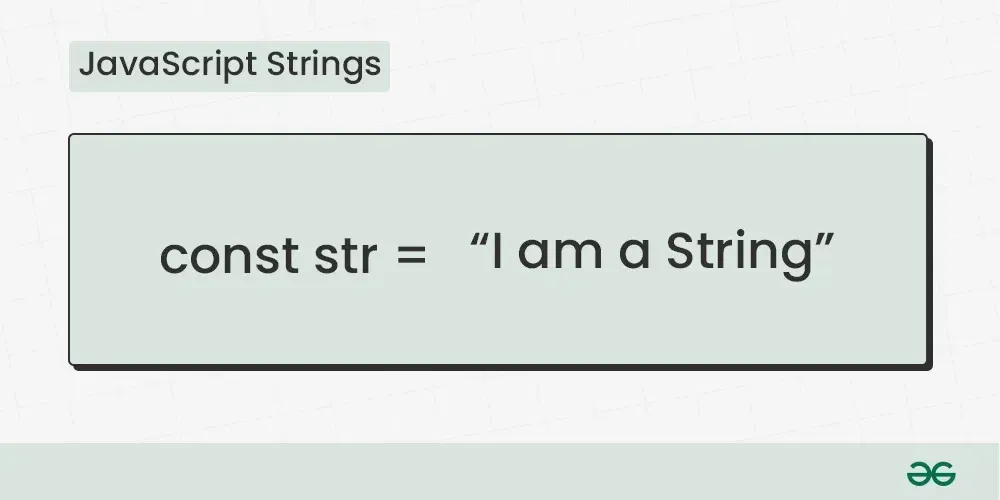A String is a sequence of characters used to represent text-based data, such as words, sentences, or symbols. Strings are one of the most commonly used data types in JavaScript and play a key role in handling user input, displaying content, and working with APIs or text files.
 Strings in JavaScript
Strings in JavaScriptString Basics
When you're starting with strings in JavaScript, the first things you'll learn are how to create a string, get specific characters based on their position, and find out how long the string is. These simple concepts might seem small, but they're the building blocks for working with text in almost every JavaScript project.
1. Declaration & Initialization
Strings can be created using single quotes (' '), double quotes (" "), or backticks quotes (` `) in JavaScript.
Example:
JavaScript
let s1 = "GeeksforGeeks"
// Using double Quote
console.log(s1)
let s2 = 'GeeksforGeeks'
// Using Single Quote
console.log(s2)
// using backticks
console.log(`${s1}`)
OutputGeeksforGeeks
GeeksforGeeks
GeeksforGeeks
2. Finding a letter by its position
Access characters using index (str[i]) or methods like charAt(i).
JavaScript
let str = "JavaScript";
// Using Index
console.log(str[0]);
// Using charAt() Method
console.log(str.charAt(1));
3. Finding a length of String
Counting how many characters it contains, including letters, numbers, spaces, and symbols.
JavaScript
let string = "GeeksforGeeks"
console.log(string.length)
Now we start Built-in String Method after reading string Basics.
Built-in String Methods
JavaScript string methods are built-in functions that allow you to manipulate, transform, search, and extract information from strings efficiently.
 Built in String Methods
Built in String MethodsManipulation
- concat(str2): Combines strings.
- slice(start, end): Extracts a portion (end not included).
- substring(start, end): Similar to slice, but handles negative indices differently.
- replace(search, replacement): Replaces first occurrence of search.
- replaceAll(search, replacement): Replaces all occurrences.
JavaScript
// Define a string variable
let str = "Mind, Power, Soul";
// Use the substring() method to extract a substring
let part = str.substring(6, 11);
// Output the value of variable
console.log(part);
- toUpperCase(), toLowerCase(): Changes case.
- trim(): Removes leading/trailing whitespace.
JavaScript
let str = " Hello ";
console.log(str.trim().toUpperCase());
Searching
- indexOf(subStr): Returns first index of subStr or -1 if not found.
- includes(subStr): Checks if subStr exists (returns boolean).
- startsWith(str), endsWith(str): Checks if string starts/ends with str.
JavaScript
let str = "JavaScript";
console.log(str.indexOf("Script"));
console.log(str.includes("Java"));
Splitting & Joining
- split(separator): Splits string into an array based on separator.
- join(separator): Joins array elements into a string with separator.
JavaScript
let str = "a,b,c";
let arr = str.split(","); // ["a", "b", "c"]
console.log(arr.join("-")); // "a-b-c"
Now we start Operators after reading Built-in String Method.
Operators in JavaScript
In JavaScript, operators are special symbols used to perform actions on values or variables. They're an essential part of how we work with strings, numbers, and other data in a program.
1. Arithmetic Operators
Perform mathematical operations. Often used with numbers but can work with strings in some cases (e.g., concatenation).
- + : Addition (or string concatenation).
- - : Subtraction.
- * : Multiplication.
- / : Division.
- % : Modulus (remainder).
JavaScript
// Addition
let num1 = 10 + 2;
console.log(num1);
// Substraction
let num2 = 10 - 2;
console.log(num2);
// multiplication
let num3 = 10*2;
console.log(num3);
// Division
let num4 = 10/2;
console.log(num4);
// Module
let num5 = 10%2;
console.log(num5);
2. Assignment Operators
Assign values to variables.
- =: Assigns a value.
- += , -= , *= , /= : Combine operation and assignment.
JavaScript
let str = "Hello";
str += " World"; // str = "Hello World"
console.log(str);
3. Comparison Operators
Compare value, often used in conditionals. Returns true or false.
- == : Equal (loose equality, converts types).
- === : Strict equal (no type conversion).
- != , !== : Not equal (loose and strict).
- > , < , >= , <= : Greater than, less than.
JavaScript
console.log("5" == 5); // true
console.log("5" === 5); // false
let str = "apple";
console.log(str < "banana"); // true
4. Ternary Operator (?:)
Shorthand for if-else.
JavaScript
let str = "hello";
let result = str.length > 5 ? "True" : "False";
console.log(result);
5. Typeof Operator
Checks the type of a value.
JavaScript
console.log(typeof "Hello"); // "string"
Now we start with some problems on strings after reading Operators.
Some Problems on Strings
Before exploring specific string problems in JavaScript, let’s understand what these problems involve and why they matter. String problems focus on techniques for manipulating and analyzing text, such as checking for palindromes, reversing strings, or compressing data efficiently.
String Reversal
Reverses the characters in a string.
JavaScript
function reverseString(str) {
return str.split("").reverse().join("");
}
console.log(reverseString("hello"));
Palindrome Check
Check if String is Palindrome or not.
JavaScript
function isPalindrome(str) {
// Convert to lowercase and remove non-alphanumeric characters
str = str.toLowerCase().replace(/[^a-z0-9]/g, "");
// Compare string with its reverse
return str === str.split("").reverse().join("");
}
console.log(isPalindrome("A man, a plan, a canal: Panama")); // true
console.log(isPalindrome("race a car")); // false
Anagram Check
Check if two strings are anagrams.
JavaScript
function isAnagram(str1, str2) {
str1 = str1.toLowerCase().replace(/[^a-z]/g, "");
str2 = str2.toLowerCase().replace(/[^a-z]/g, "");
return str1.split("").sort().join("") === str2.split("").sort().join("");
}
console.log(isAnagram("AMAN" , "MAAN"));
Explore
JavaScript Basics
Array & String
Function & Object
OOP
Asynchronous JavaScript
Exception Handling
DOM
Advanced Topics